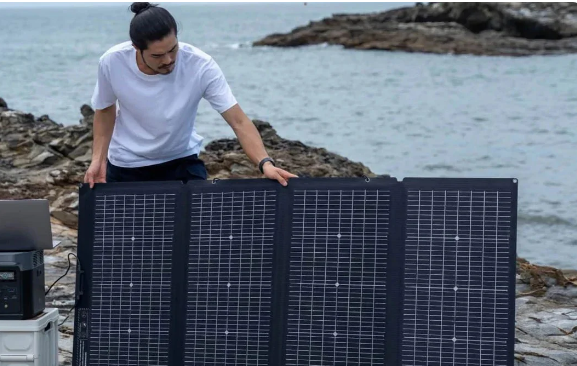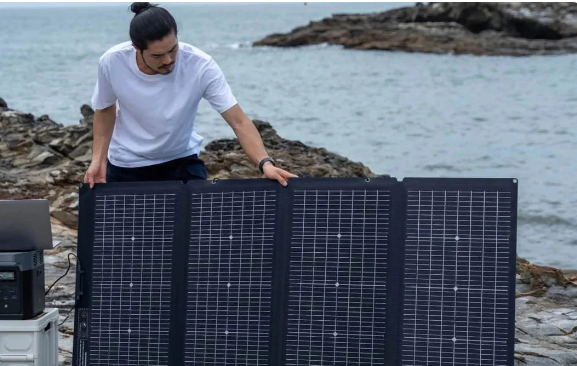How V, A, & W Determine Your Power Station Charging Time
Using a portable power station may cause you to discover different charging techniques take different times. Usually faster than running a solar panel, plugging into a wall outlet is not random. Three electrical readings—volts (V), amps (A), and watts (W)—define the difference. These settings, found on your chargers and gadgets, control the precise rate of charging your power station uses. This post defines these terms and illustrates how they interact to influence your charging time.
Foundational Charging Concepts: Watt-hours (Wh), Watts (W), Volts (V), Amps (A)
Before calculating charging times, let's establish what these key electrical terms signify when you're powering up your portable power station, not powering out.
Watt-hours (Wh): Gauging the Energy Capacity
Consider Watt-hour (Wh) as the capacity of the energy reservoir of your power station. It calculates, from full charge, the overall electrical energy the internal battery can hold. Whichever speed either can be charged or discharged, a 500Wh station has less overall energy than a 1000Wh station. Since it determines the overall "work" required to load the battery from empty to full, this capacity number is absolutely critical. Usually found clearly on the unit itself or in its specifications, this is the baseline against which charging speed is gauged.
Input Watts (W): The Speed of the Energy Flow
Watts (W), in the context of charging, represent the rate at which electrical energy is delivered into your power station's battery. It's the measure of charging power. Higher wattage means energy is flowing in more quickly. This crucial number is derived directly from the interaction of voltage and current, defined by the essential electrical formula: Input Power (Watts) = Input Voltage (Volts) × Input Current (Amps). If Watt-hours measure the size of the task (filling the tank), Input Watts measure the speed at which you're performing that task (the fuel pump's flow rate).
Input Volts (V): Ensuring Electrical Compatibility
Voltage (V) represents the electrical potential or 'pressure' that pushes the current through the charging circuit. The crucial factor for charging is compatibility. For a given input port, the voltage your charging source—AC adapter, solar panel, auto charger—supplied may sit within the allowed input voltage range indicated by your power station. Inappropriate voltage can stop charging or, worse, harm the device. For their AC input, DC/Solar input—often a broader range, like 12-30V—and automobile input—typically around 12V—power stations provide approved voltage ranges.
Input Amps (A): The Rate of Electrical Current
Amperes (A), or amps, measure the flow rate of the electrical current – how many electrons are passing a point per second. Together with voltage, current controls the total charging power (Watts). Maximum current ratings abound in the charging source itself as well as in the power station's input circuitry. The power station might restrict the current it consumes to safeguard its internal components even if a charger could theoretically provide larger amps. The capacity of input current directly affects the achievable charging wattage.
How Input Watts Dictate Charging Time
The connection between charging power and charging duration is straightforward. For a given battery capacity (Wh), the time required to charge it is inversely proportional to the input power (W). Higher power means less time.
The Fundamental Calculation
You can estimate the charging time using a simple formula:
Charging Time (in Hours) ≈ Battery Capacity (in Wh) / Input Power (in Watts)
Let's illustrate with an example. Suppose you have a power station with a 600 Watt-hour (Wh) battery capacity. If you are charging it using an AC adapter that delivers 100 Watts (W) of input power:
Charging Time ≈ 600 Wh / 100 W ≈ 6 Hours
This calculation provides a solid baseline for planning. If you were using a less powerful charger providing only 50W, the estimated time would double to approximately 12 hours (600 Wh / 50 W).
Real-World Charging Takes Longer
One should understand that the calculation above offers only an approximative time. The real process is not exactly efficient. Heat loss from internal resistance and power conversions always occurs during the charging process. This implies that the actual charging time will usually be quite more than the basic computation advises. For a more reasonable estimate, expect 10% to 20% extra added to the computed time. The real-world duration of 6.5 to 7 hours is more likely than precisely 6 hours for our 600Wh station charging at 100W. Still, the fundamental idea is that doubling the input Watts essentially reduces the charging time by half.
Charging Methods Comparison: Where V, A, & W Vary Greatly
Different methods of replenishing your power station utilize distinct voltage and current characteristics, resulting in vastly different input wattages and, consequently, charging times.
AC Wall Charging
Plugging your power station into a standard household wall outlet via its AC adapter is usually the fastest way to recharge.
How it Works: The AC adapter takes the high voltage alternating current (AC) from your wall (e.g., 120V in North America, 230V in Europe) and converts it into the specific direct current (DC) voltage and amperage required by the power station's charging circuitry.
Typical V, A, W: While the wall provides high AC voltage, the adapter outputs a specific DC voltage (e.g., 19V, 24V, 48V) at a relatively high current. This results in significant input power, ranging from around 60 Watts for smaller units to well over 1000 Watts (1kW) or even 1800W for larger, fast-charging models. A common range might be 100W to 500W.
Resulting Speed: Due to the high input wattage achievable, AC charging offers the shortest replenishment times, making it ideal when speed is paramount and grid power is available.


Solar Panel Charging
Using solar panels offers off-grid charging freedom but introduces significant variability.
How it Works: Photovoltaic panels convert sunlight directly into DC electricity. This DC output is fed into the power station's solar charge controller (often an MPPT - Maximum Power Point Tracking controller).
Variable V, A, W: The power output (W) of a solar panel constantly fluctuates based on sunlight intensity (clear sky vs. cloudy), the angle of the sun, panel temperature, and shading. A 100W panel might only produce 60-80W under excellent conditions, and significantly less on overcast days.
Panel Specifications (Vmp, Voc, Imp): It's crucial to match the panel's electrical characteristics to the power station's solar input limits. Key specs include:
Vmp (Voltage at Maximum Power): The voltage where the panel produces maximum watts.
Voc (Open Circuit Voltage): The maximum voltage the panel can produce with no load. Crucially, the Voc must NOT exceed the power station's maximum solar input voltage limit to avoid damage.
Imp (Current at Maximum Power): The current produced at maximum power. This should also be within the station's input current limit.
MPPT's Role: Most modern power stations use MPPT controllers. These sophisticated circuits continuously adjust the electrical load on the panel to operate it near its Vmp and Imp, maximizing the harvested Watts (W) under varying conditions.
Resulting Speed: Solar charging times are highly variable and generally much longer than AC charging. Charging a large station fully might take many hours or even span multiple sunny days, depending on panel size and weather.
Car Charging (12V DC)
Charging from your vehicle's 12V accessory port (cigarette lighter socket) is convenient on the road but typically the slowest method.
- How it Works: A specific car charging cable connects the 12V DC output from the car's electrical system to the power station's DC input port.
- Lower V, A, W: The car's system provides a voltage around 12V to 14.4V. The power output is usually limited by the car's socket fuse (often 10A or 15A) and the power station's input capabilities for this port. The resulting input power (W = V x A) is typically capped around 100W to 120W (e.g., 12V x 8A = 96W).
- Resulting Speed: Due to the relatively low input wattage, fully charging a medium-to-large power station via a car charger can take a very long time (potentially 10-20 hours or more), making it better suited for topping off or slow trickle charging during long drives rather than primary replenishment.
How to Apply Your V, A, & W Knowledge
Knowing how Volts, Amps, and Watts interact empowers you to manage your power station's charging more effectively.
Examine Your Power Station Specifications
Learn the handbook for your gadget or the labeling on the machine itself. For every charging port—AC, Solar/DC, Car—pay great attention to the input specifications. For every input note the maximum allowed Wattage (W), the approved Voltage range (V), and the maximum Amperage (A). Your basis is this information.
Select Appropriate Charging Accessories
Make sure the output of any AC converter, solar panel, or auto charger fits the input requirements of your power station. For solar, carefully make sure the Imp (Current at Maximum Power) falls within limitations and the Voc (Open Circuit Voltage) of the panel is below the maximum solar input voltage of the station. Complementing accessories enhances safe charging capability. The fastest charging for a given technique will come from selecting a charger or panel rated for the maximum wattage your station can accept via a designated connector.
Estimate Charging Durations for Planning
Practically, use the Time ≈ Wh / W formula. Calculate approximate charging durations depending on the input wattage of your chosen charging mode (AC, solar under expected conditions, automobile) either before a trip or during planning. Add 10–20% for efficiency losses as well. This guides your decision on when and how to charge as well as reasonable expectations.
Diagnose Why Your Charging Is Slow
If your power station seems to be charging slower than expected, your V, A, W knowledge helps diagnose the problem. Is the AC adapter the correct one, delivering the expected Watts? For solar, is it a cloudy day drastically reducing panel Watts? Are the panel's V/A specs properly matched? Is the car charger limited to a low Wattage by design? This understanding directs your troubleshooting efforts logically.
Enhance Your Charging Strategy!
Knowing how input volts, amps, and watts mix to control charging power (Watts) and how that power relates to the entire capacity of your station (Watt-hours) changes charging from a guessing game into a predictable procedure. Applying these electrical insights guarantees that your portable power station is ready as needed, so reducing downtime and optimizing its use for your travels or backup requirements.